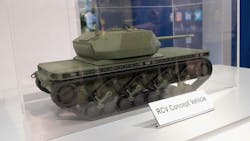General Dynamics unveils proposal for U.S. Army’s Robotic Combat Vehicle unmanned small tank project
STERLING HEIGHTS, Mich. – General Dynamics Land Systems (GDLS) in Sterling Heights, Mich., has unveiled its proposal for the U.S. Army’s Robotic Combat Vehicle acquisition project. Defence Blog reports. Continue reading original article
The Military & Aerospace Electronics take:
1 Nov. 2019 -- A concept for the program of the TL1 Robotic Combat Vehicle was displayed for the first time at the Association of the United States Army (AUSA) annual meeting last month in Washington.
The new Robotic Combat Vehicles are developing as part of Army’s Next Generation Combat Vehicle program, which in turn part of the ‘big six’ priorities of the service that also includes long-range precision fires, Future Vertical Lift, the network, air and missile defense, and Soldier lethality.
The main goal of the unmanned RCV project – a creation of the next generation of vehicles that are not only more lethal and survivable than current combat platforms but much smaller, lighter, and more fuel efficient. Soldiers in the field need the right equipment to be successful. A tank that is too heavy to cross a bridge or maneuver through rough terrain and high altitudes can have a serious impact on mission success.
John Keller, chief editor
Military & Aerospace Electronics
